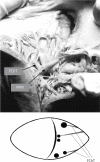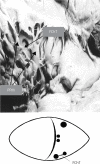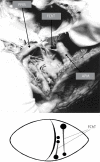False chordae tendineae in right ventricle of adult human hearts - morphological aspects
- PMID: 23185192
- PMCID: PMC3506239
- DOI: 10.5114/aoms.2012.31617
False chordae tendineae in right ventricle of adult human hearts - morphological aspects
Abstract
Introduction: False chordae tendineae are fibrous-muscular bundles which do not interconnect with right atrioventricular valves. The structures have occasionally been described in the right ventricle. There are reports suggesting their influence on electromechanical processes taking place in the heart, in thromboembolic events as well as in the course of cardiac invasive procedures. The objective of the study was to perform a macroscopic evaluation of false chordae tendineae in the right ventricle.
Material and methods: The research specimens consisted of 100 hearts of adult humans, aged from 18 to 59 years, fixed in a solution of 10% formaldehyde and 98% ethanol. The ratio of false chordae tendineae to individual elements of the right ventricle, such as its walls, papillary muscles, septomarginal trabecula and the apex of the ventricle, was examined.
Results: During examination, six types of chordae tendineae were described based on the criterion of the type of structures they connected. The most common were false chordae connecting ventricle walls within its apex, while the least common were individual segments of papillary muscles. The research proved that the examined structures are morphologically extremely diverse. Substantial clinical implications of their presence seem very probable.
Conclusions: The present work is the first of a scheduled series devoted to the problem of false chordae tendineae. Further analyses will cover the subject of morphological aspects in a microscopic perspective.
Keywords: false chordae tendineae; heart; right ventricle.
Figures








References
-
- Turner W. A human heart with moderate bands in the left ventricle. J Anat Physiol. 1893;27:19–20.
-
- Keren A, Billingham M, Popp RL. Echocardiografic recognition and implications of ventricular hypertrophic trabeculations and aberrant bands. Circulation. 1984;70:836–42. - PubMed
-
- Perry LW, Ruckman RN, Shapiro SR, Kuehl KS, Galioto FM, Scott LP. Left ventricular false tendons in children: Prevalence as detected by 2-dimensional echocardiography and clinical significance. Am J Cardiol. 1983;52:1264–6. - PubMed
-
- Suwa M, Hirota Y, Nagao H, Kino M, Kawamura K. Incidence of coexistence of left ventricular false tendons and premature ventricular contractions in apparently healthy subjects. Circulation. 1984;70:793–8. - PubMed
LinkOut - more resources
Full Text Sources
Miscellaneous
